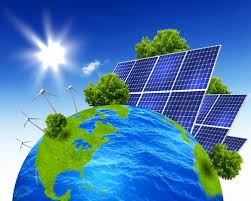Green Energy & Climate Change in Tay Valley
The climate is changing and Tay Valley Township wishes to be part of the solution to reduce greenhouse gas emissions while lowering energy costs and building a local sustainable economy. To achieve this goal, Council appointed a Green Energy and Climate Change Working Group in 2018.
|
What is Climate Change? |
|
Climate change occurs when long term weather patterns are altered. The change in climate patterns is largely associated with the increased level of carbon dioxide released into the atmosphere. The growth in carbon dioxide levels is produced by the use of fossil fuels (for example, gas, oil, diesel, natural gas). |
| What is Green Energy? |
| Green energy is energy derived from a renewable energy source. Renewable energy sources never run out, (for example, the sun, wind and waste/biomass). The energy produced using renewable energy sources is less harmful to the earth and generates less pollution. |
Ministry of Environment, Conservation and Parks
Ministry of Environment, Conservation and Parks (MOECP) is an Ontario government ministry. MOECP is responsible for coordinating Ontario’s actions on climate change. The MOECP website provides information on improving the quality of the environment in Ontario.
Tay Valley as a part of the Global Climate System
Life in Tay Valley Township is subject to a climate like of much of the mid-latitudes of North America, Europe, and Asia. This climate is “typified by large seasonal temperature differences, with warm to hot (and often humid) summers and cold winters.”[i]
The seasons we experience and which have shaped our local economy are influenced by a global climate system which is subject to extensive natural variation, over long time periods. Climate change (“a change in weather patterns when that change lasts…decades to millions of years”) is driven by factors including volcanic eruptions, movements of the earth’s crust, variations in solar radiation received by earth, and vegetation cover and extent.[ii]
Global and regional swings in climate can be extreme, as is evident by the many glacial and interglacial periods over earth’s history.[iii] It was only about 18,000 years ago, during the last Ice Age, that Tay Valley Township, like much of North America, was buried under ice about two kilometers thick.[iv] Since about 11,700 years ago, earth has been in its latest interglacial (warmer) period,[v] and this period is anticipated to last another 50,000 years.[vi]
However, earth’s climate is now being influenced by human activity, and with such potential environmental, economic, and social impact that this man-made climate change constitutes a threat to human existence.[vii] As stated by the authoritative Intergovernmental Panel on Climate Change (IPCC) in its 2018 summary report for policymakers worldwide, “we have twelve years to limit climate change catastrophe.”
As the IPCC states:
"Continued emission of greenhouse gases will cause further warming and long-lasting changes in all components of the climate system, increasing the likelihood of severe, pervasive and irreversible impacts for people and ecosystems. Limiting climate change would require substantial and sustained reductions in greenhouse gas emissions which, together with adaptation, can limit climate change risks." [viii]
Consistent with predictions of more extreme weather events associated with climate change, Tay Valley Township was subject to extreme drought in 2016,[ix] followed by extreme precipitation and flooding in the spring of 2017, and Polar Vortex effects in 2018.[x] The Township is anticipating more of such events in the future. The Township is committed to prepare itself and its residents as best we can, and to do what we can to contribute to the urgent need for reducing GHG emissions from our buildings, vehicles, and land use.
Additional Information
- NASA Global Climate Change: Vital Signs of the Planet: https://climate.nasa.gov/
- Intergovernmental Panel on Climate Change: http://www.ipcc.ch/
[i] https://en.wikipedia.org/wiki/Humid_continental_climate
[ii] https://en.wikipedia.org/wiki/Climate_change
[iii] https://en.wikipedia.org/wiki/Glacial_period
[iv] https://opinicon.wordpress.com/physical-environment/quaternary/
[v] https://en.wikipedia.org/wiki/Interglacial
[vi] https://en.wikipedia.org/wiki/Glacial_period#Next_glacial_period
[vii] https://news.un.org/en/story/2018/05/1009782
[viii] http://www.ipcc.ch/pdf/assessment-report/ar5/syr/AR5_SYR_FINAL_SPM.pdf
[ix] http://nationalpost.com/news/canada/once-in-a-decade-dryness-rainless-ontario-verges-into-drought-and-theres-no-end-in-sight
[x] https://www.canada.ca/en/environment-climate-change/services/top-ten-weather-stories/2017.html



